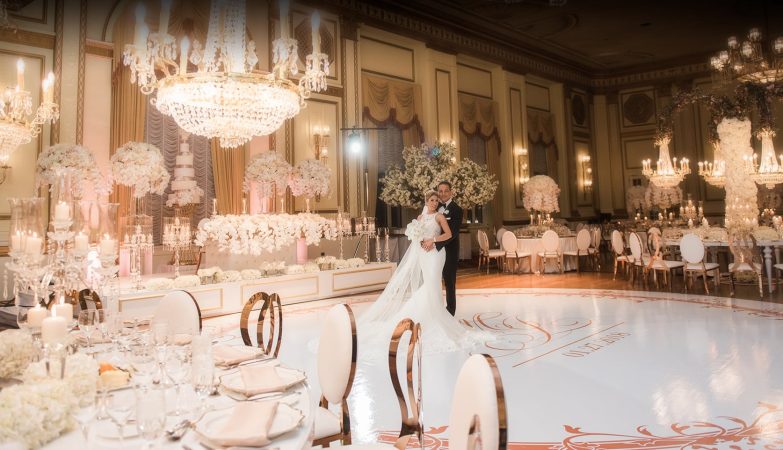
Wedding seating charts are incredibly powerful tools. With the right combination of people at each table, you give your guests the opportunity to meet, mingle and celebrate in a memorable way. Of course, not every shindig warrants a seating chart – if you’re having 25 guests at a buffet, you may or may not want to give people specific seating assignments. But if you’re having 75 guests or more and serving a seated meal, you’ll want to make sure everyone’s got a specific place to sit.
Why? For one, people like to know where they’re sitting-and that you took the time to choose where they should sit and with whom. It’s also helpful if you’re serving several different entrée choices. It will help the caterer (psst-you can find amazing caterers in your area through our new All-In-One Wedding Planner app) figure out beforehand how many chicken, beef and vegetarian dishes a given table gets, if they know who’s sitting there. Read on for wedding seating chart ideas and a few stress-free tips on how to seat your guests.
Start Early
There are couples who’ve been at kitchen tables the night before the wedding (or even wedding morning) just starting their seating chart. Don’t let this be you-you’ve got more important things to think about at that point. Sure, it’s fine to make last-minute changes, but try to get the chart mostly done at least a week before the day.
While planning your wedding seating chart might not be as glamorous as trying on gowns or tasting wedding cake samples, try to find the fun in the activity. You’ve got a unique opportunity to make introductions and group your loved ones based on chemistry and shared interests. You never know who might connect and form lasting relationships because of your seating chart!
Break It Down
Create a new spreadsheet. If you haven’t already, insert a column into your guest list document categorizing all the invitees by relationship: your friends, your family, your partner’s friends, your partner’s family, your family friends, your partner’s family friends and so on. This way, you’ll be able to easily sort the list and break it down into more logical table assortments. Now you’ll need to separate these lists into distinct tables.
Once you’ve organized your guests into groups, consider which invitees would mesh well together. Your college friends may click instantly with your high school friends, but your boss and your sorority sisters might not have as clear a connection. There are no rules when it comes to this process, but anyone curious about how to make a seating chart for a wedding should definitely keep group chemistry in mind.
Create A Paper Trail
If you’re more visual, draw circles (for tables) on a big sheet of paper and write names inside them (make sure you know how many people can comfortably be seated at each table). Or you could write every guest’s name on a sticky note and place it accordingly.
Wedding seating chart ideas are easier when you have a physical representation for each group. Using your circles for tables, play around with combinations of guests using small toys, coins, or even crayons to represent each person. We know this might sound silly, but using action figures to represent your family and pennies as stand ins for your colleagues can give you a new perspective on your wedding seating chart.
Head Up The Head Table-Or Don’t
A traditional head table is not round, but long and straight, and it’s generally set up along a wall, on risers, facing all the other reception tables. Usually the newlyweds sit smack-dab in the middle (where everyone can see them), with the maid of honor next to the groom, the best man next to the bride, and then boy/girl out from there. But you don’t have to do it that way. All the bridesmaids can sit on the bride’s side, and all the groomsmen on the groom’s. Or maybe you’re not into being on display, or you don’t want your wedding party to feel isolated from other guests. Let your wedding party sit at a round reception table or two with each other and/or with their dates, and have a sweetheart table for the two of you (to get a little one-on-one time). Another option: You two sit with your parents and let that be the head table, with the wedding party at their own tables.
Place Your Parents
Traditionally, your parents and your partner’s parents sit at the same table, along with grandparents, siblings not in the wedding party, and the officiant and their spouse if they attend the reception. But if your or your partner’s parents are divorced and are uncomfortable about sitting next to each other, you might want to let each set of parents host their own table of close family and/or friends. This could mean up to four parents’ tables, depending on your situation-or have the divorced parent who raised you (or your partner) and their spouse/date sit at the table with still-married parents.
Remember, the parent-seating question is a flexible one. Set it up in whatever way best suits everybody. If you’re unsure, don’t hesitate to talk to the parents in question about it before you make your final decision.
Tame Tensions
There may also be situations in which certain family members just do not get along. Maybe they haven’t spoken in years. Maybe the last time they saw each other at the last family wedding there was a drunken fight. Understandably, you want to keep them as far apart as possible. Think about these kinds of relationships (or lack thereof) before you even start making your chart, so you can take them into consideration in the first place and begin by seating Aunt Jane at table three and Aunt Lucy across the room at table 15. Trust us-they’ll appreciate it.
Don’t Forget The Little Ones
If you’re inviting several children to your wedding, you may want to put together a kids’ table. Give them crafts or other activities to keep them busy between courses and speeches – their parents will thank you! When crafting your wedding seating chart, try to keep families together, or at least nearby.
Of course, you’ll want to keep the ages of your children guests in mind when planning your seating chart. Kids under the age of eight will need close supervision while dining, and if there are fewer than three or four children, you may be better off keeping them with their parents at their respective tables. Thankfully, the beauty of these wedding seating chart ideas is that you can play around with options until you’ve created the perfect arrangement.
Provide Reunion Time
All of your college or high school friends will be psyched to sit at a table together. It also gives them all an opportunity to catch up with each other. Even if you have a lot of single friends you’re eager to pair off, resist the urge to create a singles table. It’s a wedding seating chart idea that has become increasingly stereotypical through the years. Instead of focusing on your guests’ romantic partnerships, seat them according to whom they know and how they’ll get along with other invitees. They’ll pair up organically if there is a connection!
originally posted on theknot.com






